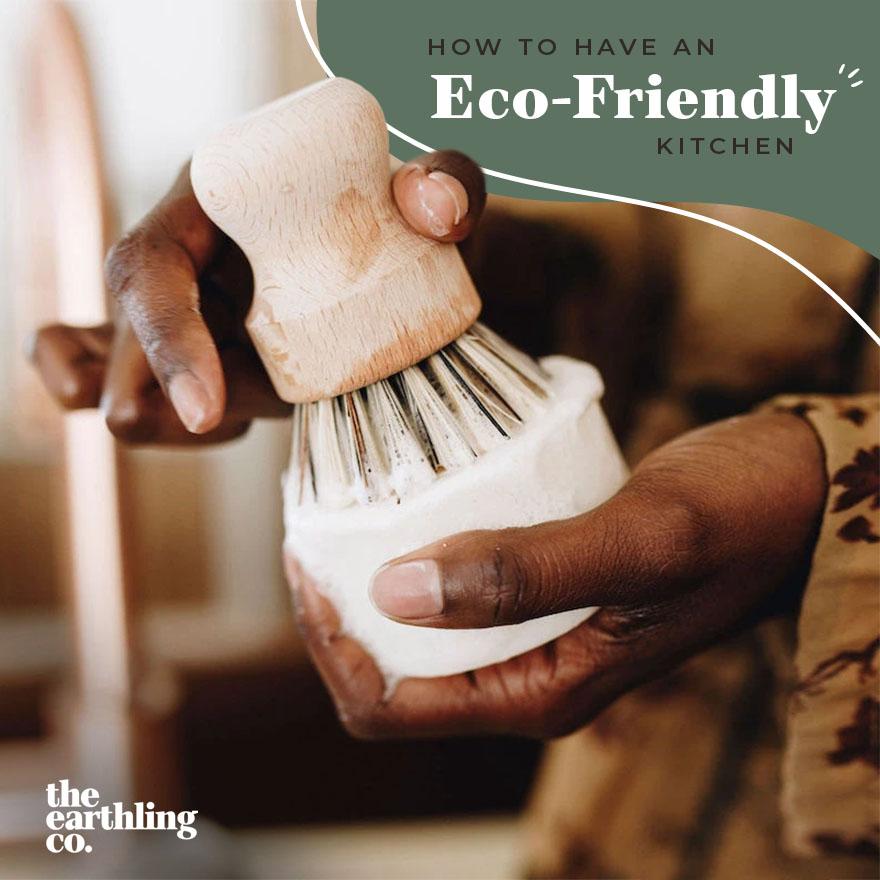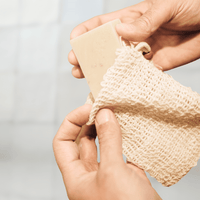
For a lot of families, the kitchen is an essential part of the home. It’s the place where you gather with loved ones, whip up delicious meals and create treasured memories that will last a lifetime. Unfortunately, all those wonderful memories and savory meals can easily generate a massive amount of waste. According to an article from The New York Times, we throw out 1.3 billion tons of food annually, or one-third of all the food we grow. And that’s just food waste! Think of all the plastic sandwich bags, cling wrap and parchment paper you toss from your kitchen every week. Not to mention how much electricity and water you use every day for cooking meals and washing dishes.
The good news? Thanks to an explosion of sustainable kitchen products, taking steps towards an eco-friendly kitchen is easier than ever. On top of helping combat waste and single-use plastics, introducing sustainable and eco-friendly products into the kitchen might actually save you money!
Ready to give your kitchen an eco-friendly upgrade? Here are a few simple ways you can go green (and save some!) in the kitchen.
1. Shop Plastic-Free
Creating an eco-friendly kitchen starts with rethinking some of your grocery shopping habits. The kitchen is usually the most wasteful area of any home, and much of this waste can be traced back to excessive packaging on grocery store shelves. But don’t worry! Cutting down on plastic waste at the supermarket is easier than you might think.
- Avoid single-use plastic bags by bringing your own reusable cotton produce bags. Cotton produce bags also make your produce last longer, which helps reduce food waste!
- Buy “naked” produce instead of pre-packed fruits and veggies.
- Take advantage of the bulk bin aisle at your local grocery store. Don’t forget to bring your own reusable containers.
- If you must buy packaged food, opt for products that are housed in paper, aluminum or glass.
- Visit your local farmers market! Getting plastic-free produce is usually much easier at a farmers market because you can shop with reusable bags and reuse the containers.

2. Buy Local and Organic
Synthetic pesticides used in conventional farming are killing wild bee populations and wreaking havoc on the environment, so try to buy organic if you can afford it. Unlike conventionally-grown food, organic food must meet strict government standards to verify its growing practices and production methods. Some of those standards involve being grown without conventional pesticides, fertilizers and other nasty biocides.
In addition to buying organic, consider getting your food from a local farmers market or a community-supported agriculture (CSA) co-op. On top of supporting your local community, buying from local farmers will help lower your carbon footprint by reducing the distance your food needs to travel in order to reach you.
3. Reduce Paper Waste
Paper towels and napkins may be convenient for wiping up spills and messes, but they usually come at a steep environmental cost. It takes a lot of trees, water, energy and fuel to manufacture paper towels, napkins and other paper products. Plus, they’re almost always packaged in plastic.
To cut down on paper waste in the kitchen, seek out reusable cloth alternatives to paper products. For example:

- Swap paper napkins for sustainable and stylish cloth napkins.
- Swap paper towels for Swedish dishcloths or reusable paper towels.
- Swap paper coffee filters with a reusable cloth filter.
- Swap parchment paper for a silicone baking mat.
If you’re not ready to quit the convenience of single-use paper towels, choose responsibly sourced paper towels made from recycled paper or sustainable grasses (e.g., bamboo and sugarcane).
4. Invest in Eco-Friendly Cookware
In the market for new cookware? Avoid Teflon at all costs. Teflon pots and pans need to be replaced every three to five years and emit long-lasting environmental contaminants into the atmosphere at high temperatures.
Instead, look for cookware that is made from long-lasting materials, like stainless steel and cast iron. Both stainless steel and cast iron are fantastically sustainable and don’t emit contaminants while being used. (Pro tip: Instead of buying new, you can be even more eco-friendly and look for cast iron skillets at thrift stores and antique stores!)
Can’t afford stainless steel or cast iron? Go for ceramic-coated pans instead. (Bonus points if you get them second-hand). While not as long-lasting as stainless steel or cast iron, ceramic pans won’t off-gas at high temperatures like Teflon.
One more thing: you can’t go wrong with a crockpot. Not only do crockpots save you time and money, but they also help reduce food waste by turning your leftovers into delicious soups and stews.
5. Rethink Your Food Storage
Plastic food storage containers tend to break easily (the lids do, anyway) and contain a worrying number of toxic chemicals that are known to be harmful to human health and the planet. Instead, look for food storage solutions that are kinder to your body and the environment.
Here are a few options:

Glass: Glass is an excellent material for food storage because it’s long-lasting, infinitely recyclable and doesn’t leach toxic chemicals into your food or the planet. Can’t afford to buy all-new glass containers? Wash out your empty spaghetti and salsa jars and use them as food storage. (Also, ask your friends if you can have their glass jars!) Repurposed glass jars make ideal storage containers for dry goods such as oats, sugar, flour, rice and uncooked pasta.
Stainless Steel: If you find glass containers to be too heavy or breakable, stainless steel is another eco-friendly option worth considering. While stainless steel can be a bit on the expensive side, it’s guaranteed to stand the test of time.
6. Prepare Meals From Scratch
Pre-packaged meals come wrapped in unnecessary plastic and are often loaded with added sugar, sodium and fat. Why not skip the plastic and the heavily processed foods by making your meals from scratch?
Whether it’s vegan taco meat or mango curry chickpeas, cooking from scratch is a great way to slash your plastic waste and your food budget while honing your culinary skills. Plus, you get to handpick the ingredients and have greater control over portion sizes, which means healthier food for you and less waste overall.
Does cooking an entire meal from scratch sound daunting? We totally get it. We recommend starting small by making your own condiments, side dishes and desserts. Homemade cakes, salad dressings and breads are super easy to whip up from scratch and taste far better than the packaged options you’d find at the store.
7. Dispose of Cooking Oil Properly
If you enjoy making meals at home, you probably use a lot of cooking oil. But hopefully, you aren’t pouring that oil down the drain afterward!
When cooking oil goes down the drain, it can build up over time and contribute to so-called "fatbergs" that block sewage pipes. These fatbergs can lead to wastewater flooding, which threatens humans, wildlife and the local environment.
Rather than pouring your leftover olive oil down the drain, keep a designated container under the sink to collect your used cooking oil. Once the container is full, take it to a local recycling center that accepts cooking oil. You can also freeze the oil in a metal can and toss it in the trash on collection day as the last resort.
![]()
8. Opt for a Greener Clean
From dish soap to multi-purpose cleaner, everyone has a few tried-and-true cleaning products to keep their kitchens sparkling clean. Unfortunately, many traditional cleaning products contain a host of toxic chemicals that may be detrimental to your health and the planet.
Take conventional dish soap for example. Dishwashing liquid often contains a bevy of highly toxic ingredients — including formaldehyde, triclosan and sulfuric acid — that have been linked to cancer, endocrine effects, aquatic toxicity and more.
For a greener, less chemical-y clean, opt for solid dish soap instead. Made from plant-based ingredients, our solid dish soap is equally as tough on grease as conventional dishwashing liquid, minus the toxic ingredients and plastic bottle! When not in use, let it drain on a wooden soap dish. (For best results, pair it with our wooden dish brush.)
Need to wipe down your countertops? Ditch your go-to multi-purpose cleaner for a homemade cleaner with simple ingredients, like baking soda and vinegar. Not only will you be saving yet another plastic bottle from a landfill, but you’ll also rest easy knowing that your household cleaner is safe for your family and the planet.
Try Our Solid Dish Soap Today!9. Compost Your Food Scraps
Contrary to popular belief, biodegradable food scraps such as eggshells and orange peels don't break down in landfills. That's why composting in the kitchen is so important. By feeding your food scraps to your compost pile, you can put nutrients back into the earth in a beautiful, closed-loop cycle.
Composting can seem complicated at first, but it’s simpler than you might think. In fact, it could be as easy as collecting your food scraps in a countertop compost bin and dumping them into the dirt or a composting tumbler in your backyard. If you don’t have room for an outside compost bin, you can always make a worm bin (aka, vermicomposting).
You can also take your kitchen scraps to a community garden or give them to people who raise chickens. Either way, you'll be reducing your food waste and putting nutrients back into the ground.
10. Say No to Unnecessary Kitchen Tools and Gadgets
It seems like every household has a drawer dedicated to oddly specific kitchen tools and gadgets. Whether it’s an avocado slicer, an onion chopper or a lemon squeezer, most of these items are plain unnecessary and destined to end up in a donation box (or worse, the trash).
In the future, try to be more selective about the kitchen products you bring into your home. Whenever possible, try to look for versatile kitchen items that serve multiple functions — like a food processor that doubles as a blender or silicone food covers that can stretch over bowls, cans and fruit alike.
11. Practice Energy-Efficient Cooking
When it comes to creating an eco-friendly kitchen, food waste and plastic waste always take the lion’s share of attention. But what about energy waste? The unfortunate truth is that fossil fuels continue to power the machines we use to whip up our delicious meals.
To help keep your gas consumption low, practice energy-efficient cooking with these tips:

- Cook meals in bulk and store leftovers in the refrigerator and freezer until you’re ready to eat them.
- Make sure you’re using the correct sized pots and pans. There’s no sense in using a large pan for a small meal.
- Cook your meals using smaller appliances whenever possible. For example, use a toaster oven instead of a regular oven.
- Turn the temperature off early and allow the residual heat to finish the cooking for you.
- Put the lid on your pot to increase cooking speed.
Go Green — and Save Some — with The Earthling Co.
From composting your food scraps to choosing environmentally-conscious cookware, there are lots of things you can do to make your kitchen more environmentally-friendly. But sometimes, the hardest part is taking that first step. That’s where we (The Earthling Co.) can help! From solid dish soap to reusable mesh produce bags, we have a wide range of sustainable kitchen products that can help you save money and go green at the same time.
Image Credits
TWINS DESIGN STUDIO/Shutterstock.com
Arina P Habich/Shutterstock.com
ONYXprj/Shutterstock.com
everydayplus/Shutterstock.com
Mirage_studio/Shutterstock.com
Anton Starikov/Shutterstock.com
Jan phanomphrai/Shutterstock.com
AlenKadr/Shutterstock.com
Monkey Business Images/Shutterstock.com






